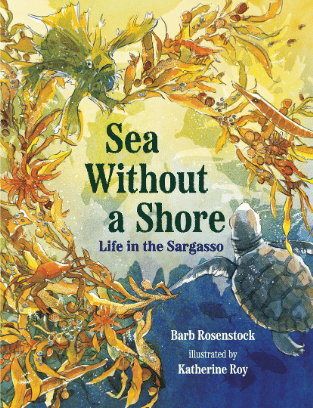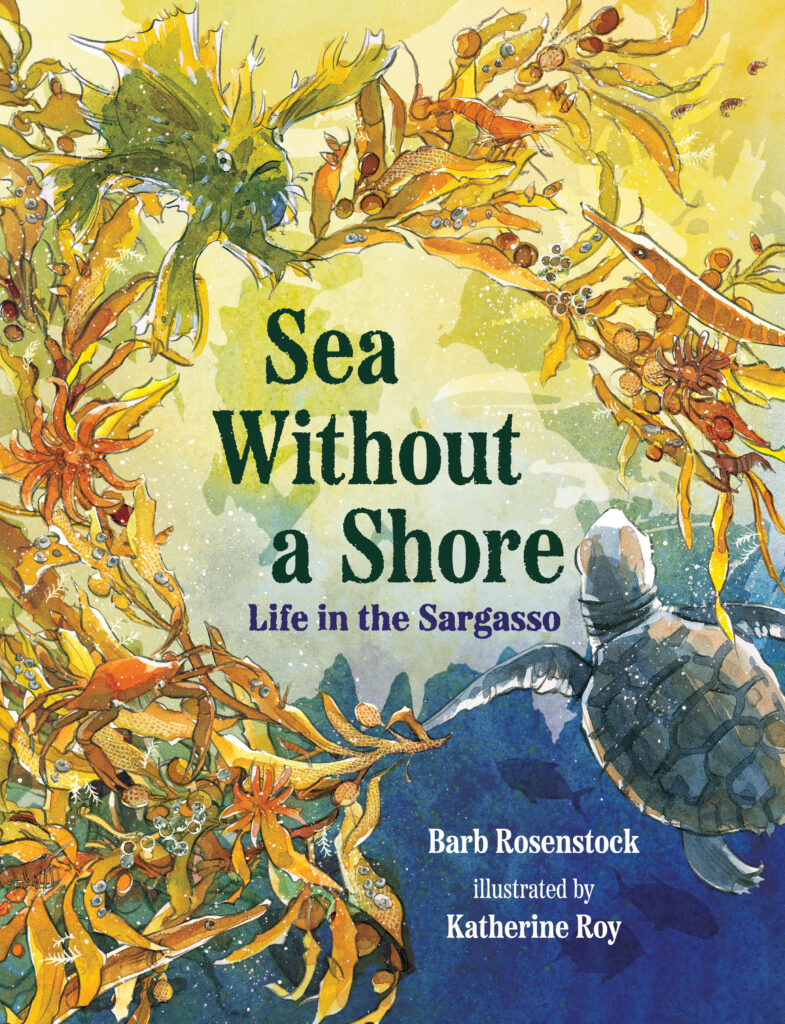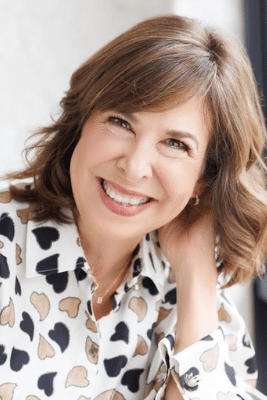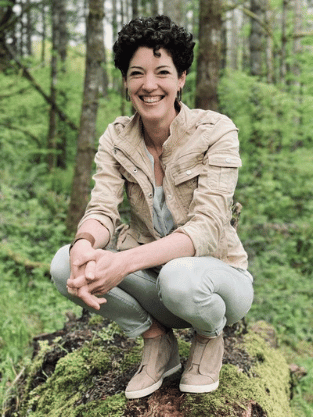An interview about Sea Without Shore with Barb Rosenstock, Katherine Roy and The Children’s Book Review.
In a joint interview about their children’s book, Sea Without Shore, Barb Rosenstock and Katherine Roy discuss their inspirations and choices that made this book come to life.
The mesmerizing book starts with children on a beach to establish a relatable context before diving into the wonders of the Sargasso Sea. Both Rosenstock and Roy highlight the book’s theme of interconnectedness, reflecting on how diverse marine life mirrors human communities and the importance of understanding and preserving these environments.
Tell us a little about the inspiration for the book—what prompted you to devote your considerable expertise in marine conservation to writing a children’s book?

Barb Rosenstock (BR): The inspiration came about on a beach walk. My feet got tangled in bunches of dried seaweed and while pulling it off, I took a good look at it for the first time. Why did it have “berries”? Was it always this ugly brown color? What was the dried lattice stuff covering its “stems”? I knew nothing about Sargassum—I was simply fascinated after a simple internet search on my phone, and the journey to this book took off from there. And thanks for the shout out, but I am not even a beginning “expert” in marine conservation! All the ocean expertise came from the scientists we interviewed. I just know how to translate that expertise into a story that kids (and hopefully their caregivers) will find fascinating.
One of the book’s best features is its fantastic artwork. Can you tell us about the decision to illustrate in watercolors rather than, for example, real-life photography?
Katherine Roy (KR): I absolutely love books about science that are filled with photographs of the natural world, but photography comes with a lot of barriers, especially for a subject as remote as the Sargasso Sea. For one, I do not have the physical or technological ability to capture beautiful underwater images, starting with my mediocre swimming skills. But for another, a photograph can only do one thing at a time, while an illustration can do many things at once, such as contain multiple moments of time, use metaphor to explain a concept, or show a cast of characters doing a complicated task with ease. If I am going to make art for a book that starts with six kids on a beach and ends with a pod of humpback whales, I want to be able to control the visual storytelling from start to finish.
We love the way the story of the sargassum functions as a metaphor for communities and diversity in human environments. Was that something you were deliberately considering as you wrote the text?
BR: Yes, for certain. This was always a book about home. For all these weird, wonderful, tiny creatures who exist way out in the ocean, Sargassum seaweed IS home—the only solid, safe place to hang out in a very threatening, watery desert. While researching and writing, the Sargassum and its creatures reminded me of a neighborhood of very different people. However, it was the illustration choices that really brought this theme forward. Katherine is a genius…truly.
KR: Remind me to argue with Barb later about how she’s the genius here, but yes, I agree—from the start I envisioned this book with a diverse cast of human kids. Bermuda is the only land mass that touches the Sargasso Sea, and the people who live there—where every horizon is the sea itself—are a diverse population, and that deserved calling attention to in our book. Globally speaking, the health of every sea and every ocean impacts the health of every human being, even if you live 1,000 miles from any coast. We are all interconnected.
The opening scenes of the book feature children playing with seaweed on a beach, rather than moving straight to depiction of the Sargasso Sea. What was the reason for focusing first on humans?
KR: Barb’s first lines of the book are quite impossible to illustrate. She writes: “In the middle of nowhere, hundreds of miles into the Atlantic Ocean, five currents swirl billions of gallons of water…” There is just no literal way to draw or show “billions” of gallons of water, because you need context to demonstrate scale, which requires showing continents. So right away, I had a problem: I had to begin with a map, or I had to do something else entirely. And maps are no way to start a children’s book, so I had to find a different solution. I came to see that the only beginning that could work would be to show a group of kids discovering fresh sargassum seaweed on a beach, because a kid reader can only understand a story if they have a point of connection. Even though some children have never seen the ocean, I could be fairly sure that they would know what an ocean is. A story about a journey must begin with the known before it can carry the reader into an unknown world.
If there is one thing you want readers to remember about life in the Sargasso Sea, what is it and why?
BR: That our actions as humans have far reaching effects on places we will never visit. Seeing turtles mid-Atlantic tangled in plastic is proof of that. Every creature has a right to live as natural a life as possible.
KR: What Barb said, and also that life is beautiful. Beautiful. Even weird, ugly creatures with funny fins and big teeth. Even undiscovered creatures that have yet to be named. I try my best to make beautiful art because I want to catch a kid’s attention. I want to fill my readers with wonder, I want them to care. Because if they care, maybe they will try. To protect. To educate. To conserve.
In the informational notes at the end, you mention how news media can sometimes be misleading about ocean conservation issues. For readers interested in conservation, what sources (apart from the website already listed) would you recommend for less simplified perspectives?
BR: The websites in the back matter are specific to the Sargasso Sea. As in all issues, I think it’s most important to read widely, one source is never, never enough. In general, I’d take a look at the work of the Marine Conservation Society, Oceana, Ocean Conservancy and Mission Blue most of which have programs that work with children, the next generation of ocean caretakers. Katherine, do you have any suggestions?
KR: When I do a deep dive on any complicated conservation subject, I depend on official websites like those that Barb mentioned along with plenty of peer-reviewed scientific articles. But I also gain a lot of insight and connection by finding and following different key figures in the field—for example Sylvia Earle—who has given countless interviews that you can find all over the internet and social media. I trust her summary and presentation of conservation issues far more than any news bite that might make the rounds. Read from more than one source, always!
Although the informational notes focus on conservation, the story itself is very positive, showing the marine environment as thriving rather than under threat. Please tell us a little bit about this decision.
BR: I see the marine environment as BOTH thriving AND under threat. When writing for kids about conservation issues, I believe in the truth of the quote from Senegalese scientist Baba Dioum, “…we will conserve only what we love; we will love only what we understand…” If we present our environmental problems as hopeless, then what do we expect kids to do with that information? Despair only feeds inaction. My intention is to make kids curious, to make them ‘fall in love’ with places far from home and help them understand the interrelatedness of all environments. I want to feature the ongoing, joyful work of real people/organizations who are out there helping. And helpers are everywhere in this world, especially in classrooms full of young children. At its most basic, I hope this book encourages future ocean helpers.
What advice do you have for readers who want to help preserve environments like the Sargasso Sea? Are there things they can do themselves to help with ocean conservation?
KR: There are a lot of small changes that we can each make that add up to a big difference. We can recycle. We can avoid single-use plastics. We can make sure to throw away our trash properly, so that it doesn’t reach streams and oceans. We can reduce our water consumption and energy use—not leaving faucets and lights on when we’re not using them. We can also do things like carpool, bike, or ride the bus to school to cut down on pollution. And our actions don’t have to be perfect to make a difference. One change here and there adds up to lots of change over time!
What other favorite ocean stories would you recommend to readers who have enjoyed Sea without a Shore?
BR: For each of my books, my website includes text sets for educators or parents. Children’s books related to SEA WITHOUT A SHORE include: Over and Under the Waves by Kate Messner and Christopher Silas Neal, Down, Down, Down, a Journey to the Bottom of the Sea by Steve Jenkins and The Ocean Gardner by Clara Anganuzzi.
KR: I love include Out of the Blue by Elizabeth Shreeve and Frann Presoton-Gannon along with Coral Reefs and Island by Jason Chin. And Barb and I collaborated on a book that is both our favorites, Otis and Will Discover the Deep, about Will Beebe, Otis Barton and the first deep ocean dive of the bathysphere. It’s a true ocean adventure story!
What comes next—will you create similar picture books about other iconic marine environments? (We’d love to see a book about shark nurseries in Mangrove forests!)
BR: Are you psychic over there? After a recent trip to Florida, I kind of fell in love with mangrove forests and have been reading and reading about them. Katherine has already written about great whites in Neighborhood Sharks, I’m in love with mangrove forests, maybe that WILL be the next book …
In the meantime, my next books are a true ghost story for older readers called American Spirits as well as a picture book about Harry Houdini called Houdini’s Library, both set far from the ocean.
KR: I love working with Barb, so if she’s set on sharks and mangrove forests then I am in!
About the Book

Sea Without a Shore
Written by Barb Rosenstock
Illustrated by Katherine Roy
Ages: 4+ | 32 Pages
Publisher: W. W. Norton | ISBN: 9781324016076
Publisher’s Book Summary: A single piece of seaweed buoys a fascinating ecosystem in this nonfiction picture book from award-winning creators Barb Rosenstock and Katherine Roy.
From bryozoans and snails to shrimps, eels, swordfish, and whales, the Sargasso Sea provides a home to countless types of marine life, thanks to the prevalence of microalgae called sargassum. Following a single blade of this extraordinary seaweed as it grows and spreads, readers see what it provides for the sea’s organisms: a base for hydroids and tube worms to filter and feed, shelter for anemones and nudibranchs and their nutritious waste, hunting grounds for crabs and amphipods, and a source of nourishment and protection for the fish, birds, whales, and reptiles that feed on these smaller creatures.
Through a widening scope on this intricate interdependence, Barb Rosenstock celebrates one of our planet’s most diverse and important ecosystems and the unassuming seaweed that sustains it. Gorgeously illustrated with Katherine Roy’s rich, eye-catching artwork, Sea Without a Shore is as fluid and rhythmic as the currents that shape this tidal home.
Buy the Book
About the Author
Barb Rosenstock is the author of several children’s books, including The Noisy Paint Box, which received a Caldecott Honor. She lives in Chicago, Illinois.

About the Illustrator
Katherine Roy is the creator of the Sibert Honor Book Neighborhood Sharks and, most recently, Making More. She lives in Corvallis, Oregon.

This interview—An Interview with Barb Rosenstock and Katherine Roy, ‘Creators of Sea Without Shore’—was conducted between Barb Rosenstock, Katherine Roy, and Dr. Jen Harrison.

